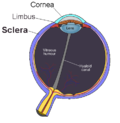Sclerocornea: Difference between revisions
CSV import |
CSV import |
||
| Line 26: | Line 26: | ||
{{Congenital disorders}} | {{Congenital disorders}} | ||
{{stub}} | {{stub}} | ||
<gallery> | |||
File:Autosomal dominant - en.svg|Sclerocornea | |||
File:Sclera.PNG|Sclerocornea | |||
File:Phenotypic appearance in patients with sclerocornea, aphakia, and microphthalmia.jpg|Sclerocornea | |||
File:Vertebrate eye development (human eye).jpg|Sclerocornea | |||
File:Penetrating keratoplasty.JPG|Sclerocornea | |||
File:US Navy 040128-N-8861F-001 Hospital Corpsman 2nd Class Jamie Zhunepluas from Queens, N.Y., gets a slit lamp eye exam by Lt. Cmdr. Jacqueline Pierre from Shelbyville, Texas.jpg|Sclerocornea | |||
File:Congenital eye diseases associated with neural crest defects in the anterior segment.jpg|Sclerocornea | |||
File:Figure 4 RAD21 Functions in various cellular processes. .tif|Sclerocornea | |||
</gallery> | |||
Revision as of 00:49, 20 February 2025
Sclerocornea is a rare, congenital anomaly that affects the cornea of the eye. It is characterized by the partial or complete absence of the corneal limbus, leading to a non-transparent cornea that resembles the sclera, the white part of the eye.
Symptoms and Signs
Patients with sclerocornea often present with visual impairment or blindness. The condition may be associated with other ocular and systemic abnormalities, such as microphthalmia, aniridia, and Peter's anomaly.
Causes
The exact cause of sclerocornea is unknown, but it is thought to be due to a developmental defect during embryogenesis. It can occur sporadically or be inherited in an autosomal dominant or autosomal recessive manner.
Diagnosis
Diagnosis of sclerocornea is primarily based on clinical examination. Slit lamp examination may reveal a non-transparent cornea with no clear distinction between the cornea and the sclera. Additional tests, such as ultrasound biomicroscopy and optical coherence tomography, may be used to further assess the structure of the eye.
Treatment
There is currently no cure for sclerocornea. Treatment is aimed at managing the symptoms and preventing complications. This may include the use of contact lenses or corneal transplantation. However, the prognosis for visual recovery is generally poor.
See also
| Eye diseases and disorders | ||||||||||
|---|---|---|---|---|---|---|---|---|---|---|
This eye diseases related article is a stub.
|
NIH genetic and rare disease info
Sclerocornea is a rare disease.
| Rare and genetic diseases | ||||||
|---|---|---|---|---|---|---|
|
Rare diseases - Sclerocornea
|
| Congenital Disorders | ||||||||
|---|---|---|---|---|---|---|---|---|
This congenital disorder related article is a stub.
|









